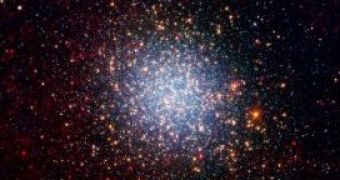Globular star clusters are believed to be amongst the oldest objects in the universe, some of them probably being more than 12 billion years old. Our galaxy, the Milky Way, is home to about 200 globular star clusters, amongst which the Omega Centauri star cluster, the biggest and brightest of all. Although it is located about 18,300 light years away from Earth, the Omega Centauri star cluster is clearly visible with the naked eye in the Centaurus constellation, as it orbits through the galaxy.
Recent observations with the Spitzer Infrared Observatory revealed the dust thrown into interstellar space by older stars. "Now we can see which stars form dust and can begin to understand how the dust forms and where it goes once it is expelled from a star. Surprisingly, Spitzer revealed fewer of these dusty stars than expected," says Martha Boyer from the University of Minnesota.
While most stars inside globular star cluster have roughly the same age, Omega Centauri seems to present unusual stellar age variation as well as different metallicity levels. The explanation for these strange measurements would only suggest that the Omega Centauri globular star cluster is actually the core of a dwarf galaxy that merged with the Milky Way some time back into the past.
The infrared images taken by Spitzer clearly identify stars according to the color of the light they give off. As you probably already know, older stars tend to emit more light towards the red end of the electromagnetic spectrum, while younger stars generally emit blue-white light. Note that not all red dots in the image are stars; distant galaxies may appear as well.
"As stars age and mature into red giants, they form dust grains, which play a vital role in the evolution of the universe and the formation of rocky planets. Spitzer can see this dust, and it was able to resolve individual red giants even in the densest central part of the cluster," said Jacco van Loon from Keele University, principal investigator of the study.
Alternatively, observations conducted with the Hubble Space Telescope and the Gemini Observatory suggest that the Omega Centauri globular star cluster contains a medium-size black hole, supporting the opinion that the star cluster may actually be a galactic core.

 14 DAY TRIAL //
14 DAY TRIAL //